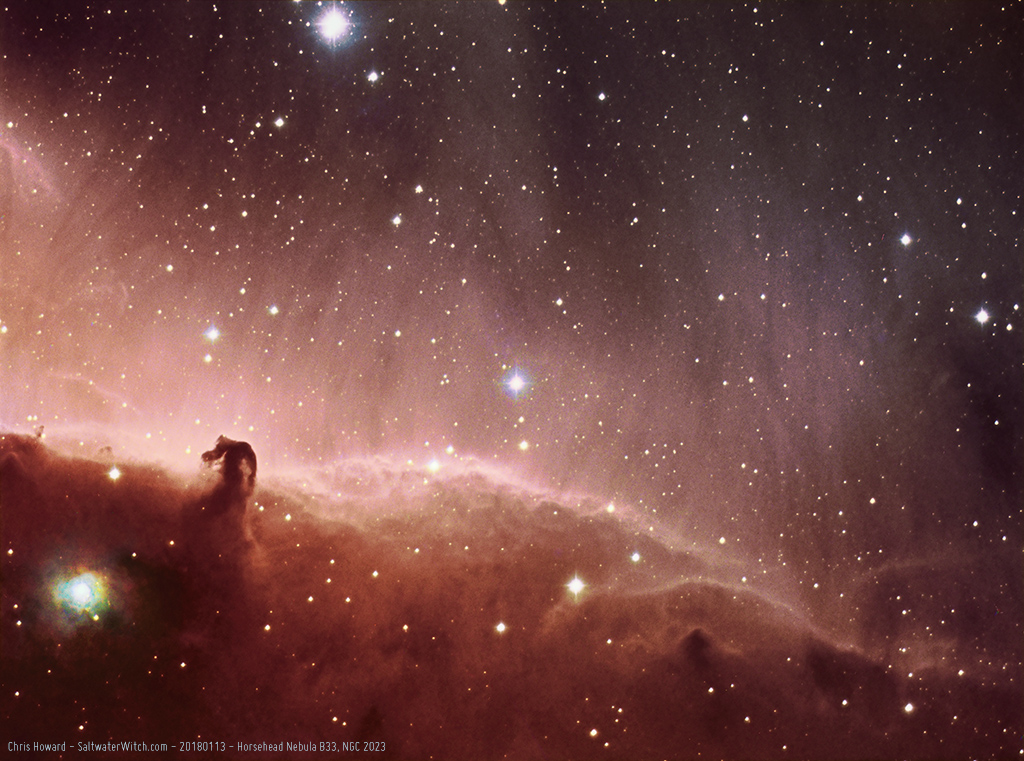Astro Session - April 22, 2018
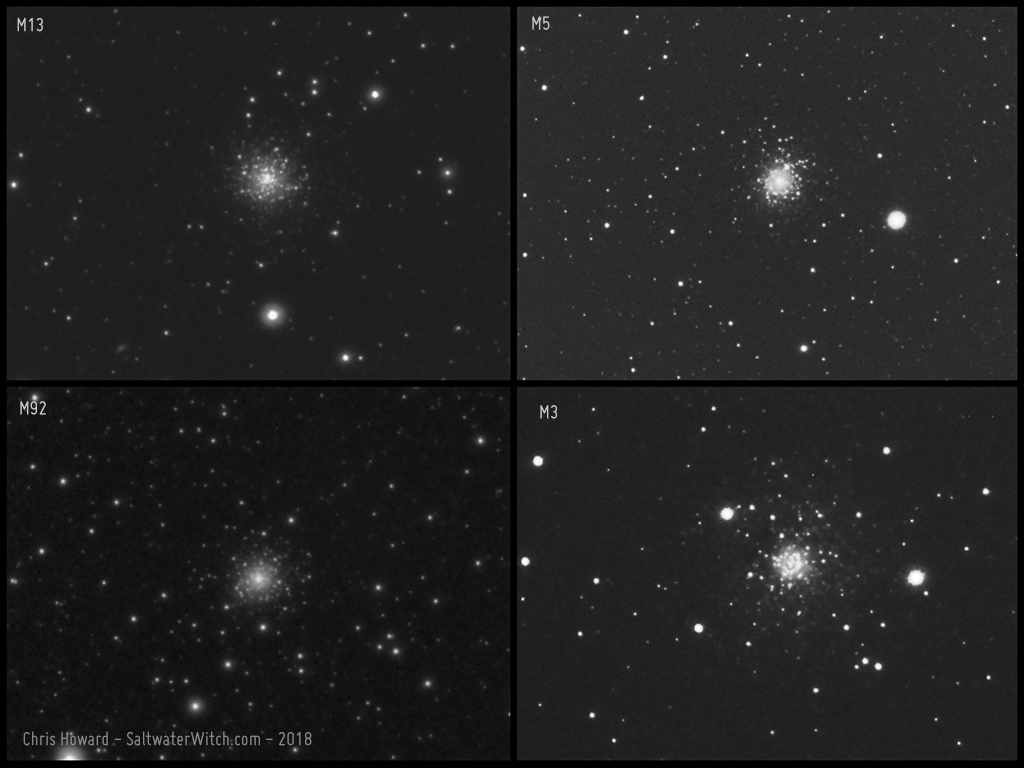 Although the skies were clear last night, the "seeing" wasn't great--"seeing" refers to the amount of atmospheric interference from temperature changes, convection currents, and other funny stuff going on in the air above your telescope. I did get to test out the Pentax 200mm f/4 lens with the Atik 414EX monochrome CCD, and an Ha longpass filter. These clusters are fairly small, so this isn't a very good setup for shooting them, but here you go anyway. Top left: the 300,000 stars that make up Messier 13 (NGC 6205), a globular cluster in the constellation Hercules. Messier 5 in the constellation Serpens. The M3 globular cluster the constellation Canes Venatici. Messier 92 (NGC 6341) is another cluster in the constellation Hercules.
Although the skies were clear last night, the "seeing" wasn't great--"seeing" refers to the amount of atmospheric interference from temperature changes, convection currents, and other funny stuff going on in the air above your telescope. I did get to test out the Pentax 200mm f/4 lens with the Atik 414EX monochrome CCD, and an Ha longpass filter. These clusters are fairly small, so this isn't a very good setup for shooting them, but here you go anyway. Top left: the 300,000 stars that make up Messier 13 (NGC 6205), a globular cluster in the constellation Hercules. Messier 5 in the constellation Serpens. The M3 globular cluster the constellation Canes Venatici. Messier 92 (NGC 6341) is another cluster in the constellation Hercules.
Posted April 22, 2018
Astro Session - April 5, 2018
As the days become longer, as we swing around our sun, headed for aphelion in July (greatest distance from the sun), and our planet's 23.5 degree tilt is angled toward its rays, we'll be seeing less of the constellation Orion--in normal viewing hours. I took this 30 second exposure last night around 9PM, and Orion is already moving below the trees to the southwest. That's the Pleiades (M45) at the far right. I also happened to capture the headlights and brakelights of Alice's car as she's driving past to our driveway, almost home after picking up Christopher from work.
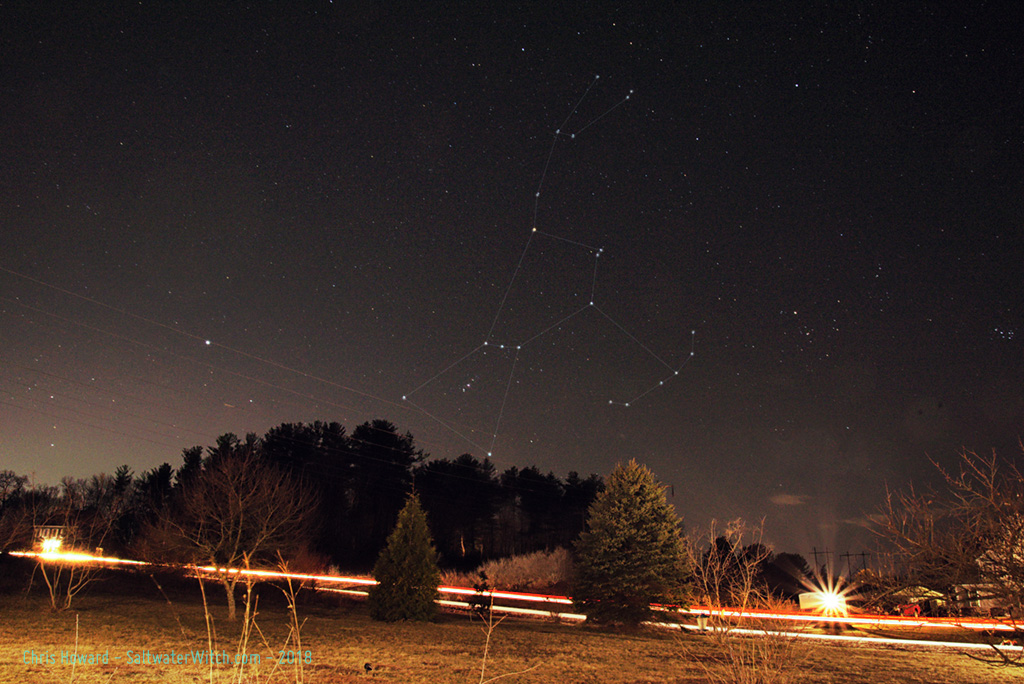
Posted April 5, 2018
Astro Session - March 16, 2018
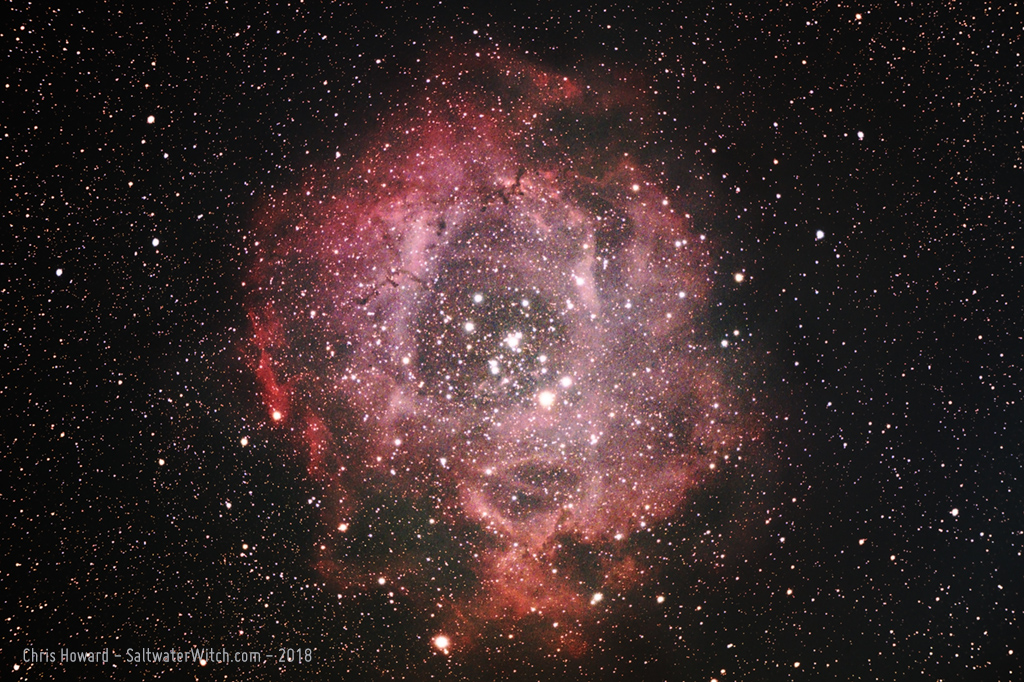 This was the first chance I've had to put the ZWO ASI071MC through some serious long exposure tests on four very different targets, the region around Alnitak in Orion, the Rosette Nebula, Markarian's Chain, and M101. I ran most of these frames with unity gain (90 Gain, 20 Offset), and I built up a nice library of dark calibration frames in the afternoon, for 600, 300, and 120 second exposure times.
This was the first chance I've had to put the ZWO ASI071MC through some serious long exposure tests on four very different targets, the region around Alnitak in Orion, the Rosette Nebula, Markarian's Chain, and M101. I ran most of these frames with unity gain (90 Gain, 20 Offset), and I built up a nice library of dark calibration frames in the afternoon, for 600, 300, and 120 second exposure times.
Rosette Nebular Region - Caldwell 49 (13 x 300 sec frames, 24 dark calibration frames) in the constellation Monoceros, about 5000 lightyears from earth. William Optics GT81 APO refractor, ZWO ASI071MC-C camera, iOptron CEM25P EQ mount.
A whole string of galaxies millions of lightyears from earth. Markarian's Chain in the Virgo Cluster, including M84, M86, the Eyes Galaxies (NGC 4435 and NGC 4438) and a few more galaxies and galaxy pairs. The Eyes are 52 million lightyears away! 30 x 120 sec frames, 20 dark frames, stacked in DSS. William Optics GT81 APO refractor, ZWO ASI071MC-C camera, iOptron CEM25P EQ mount.
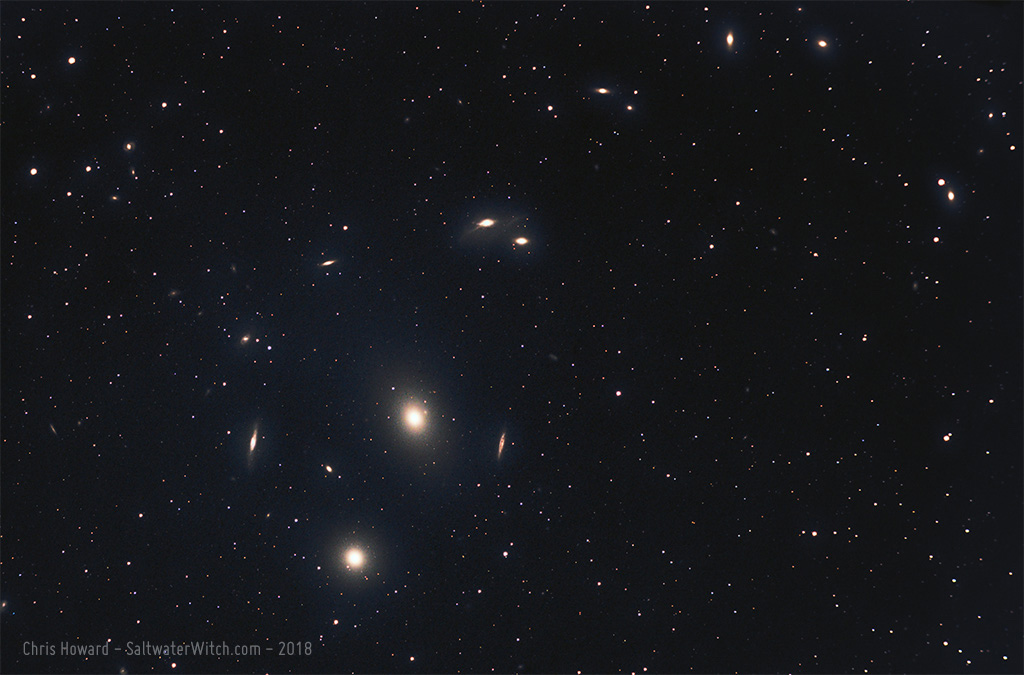
Pinwheel Galaxy, M101, a spiral galaxy about 21 million lightyears from earth in the constellation Ursa Major (Big Dipper). (Light frames: 10 x 120 secs, 4 x 600 secs, 12 x 300 secs). William Optics GT81 APO refractor, ZWO ASI071MC-C camera, iOptron CEM25P EQ mount, INDI/KStars/Ekos.
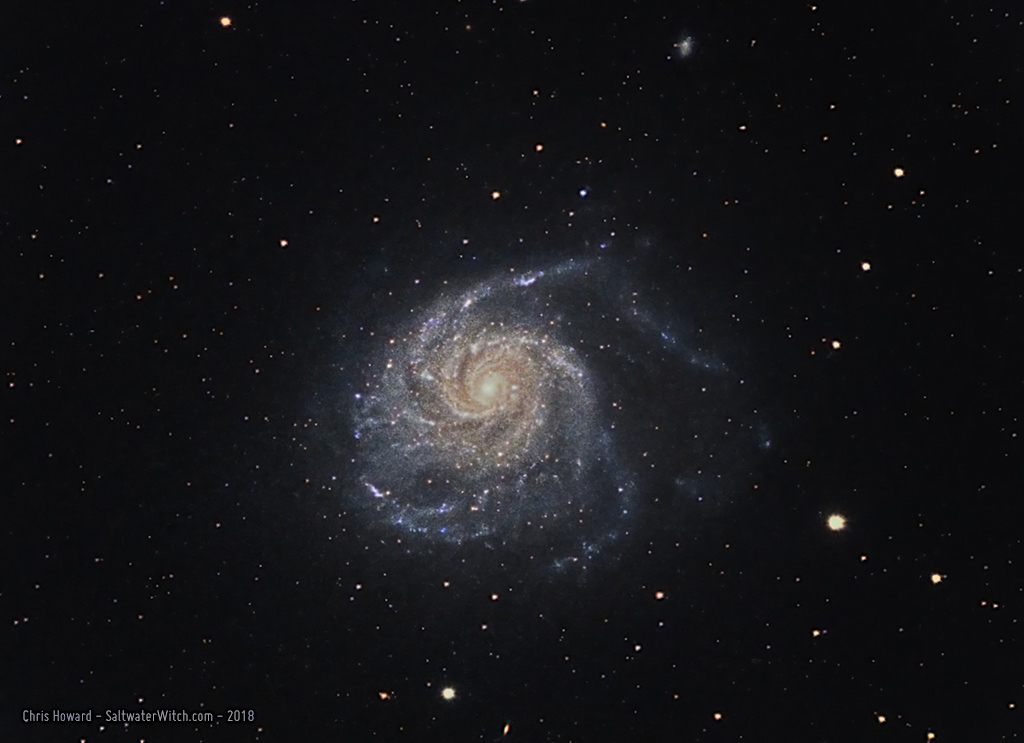
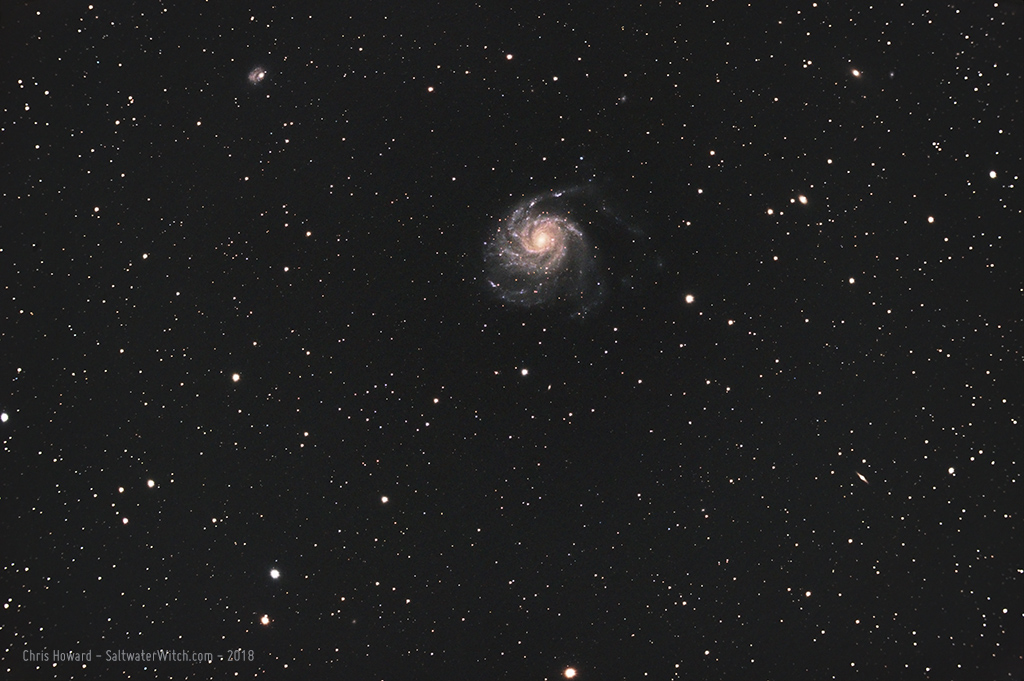
Part of the Orion Molecular Cloud Complex that surrounds the blue supergiant Alnitak (large star in the center), including the Flame Nebula (NGC 2024), IC 434, Horsehead Nebula (Barnard 33), NGC 2023, IC 431, and more. About 1500 lightyears from earth. (22 x 300 sec frames, 24 dark frames). William Optics GT81 APO refractor, ZWO ASI071MC-C camera, iOptron CEM25P EQ mount. In case you're wondering, I'm pretty damned excited about this camera (ZWO ASI071MC), just going off what it can capture in faint nebulosity, and what I can bring out without much effort by stretching 22 stacked frames. I can't wait to see what I can capture in the summer when the big galaxies like Andromeda and Triangulum swing through.
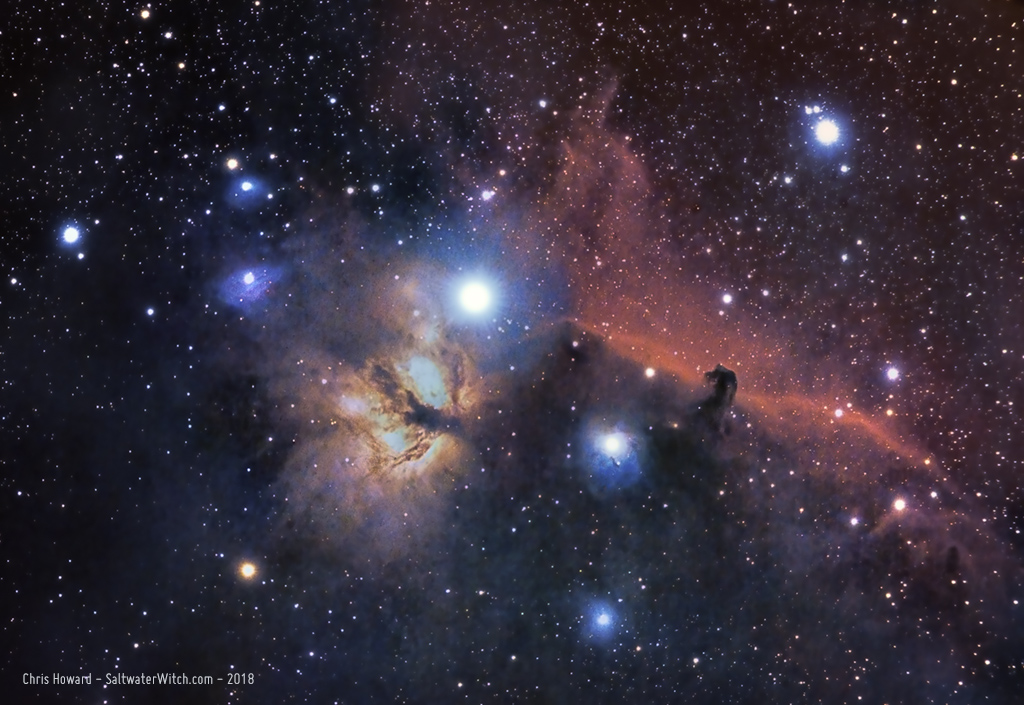
Here's my setup for last night's astro session, with the William Optics GT81 APO refractor, ZWO ASI071MC-C primary camera, iOptron CEM25P EQ mount.
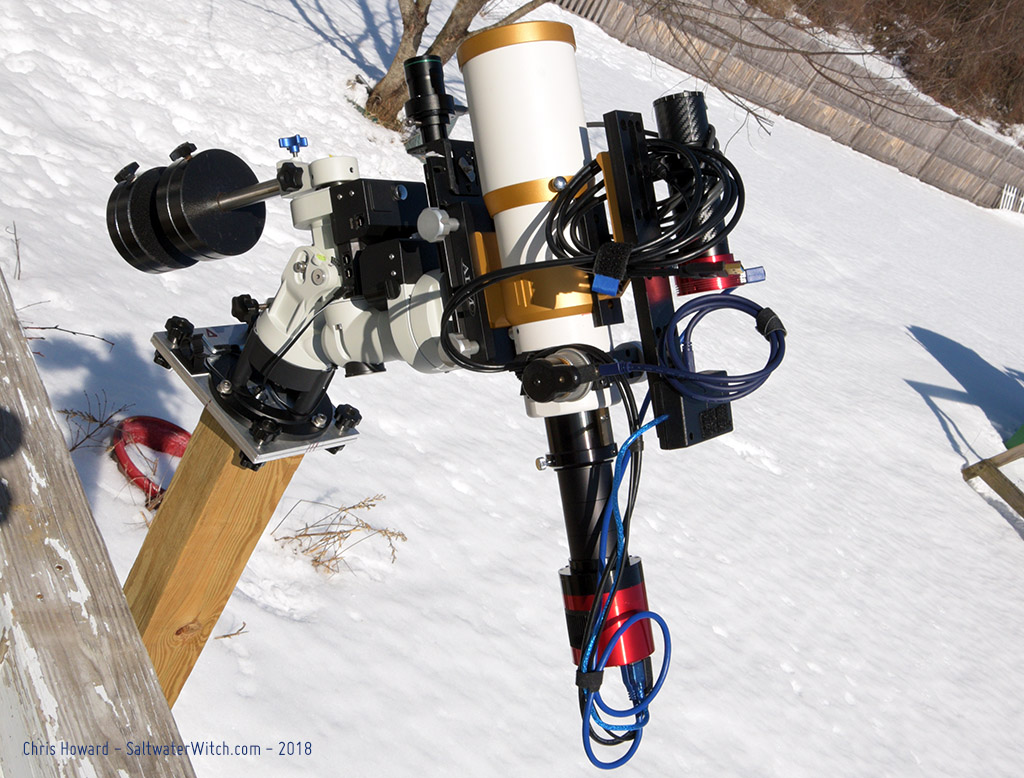
Posted March 16, 2018
Astro Session - March 11, 2018
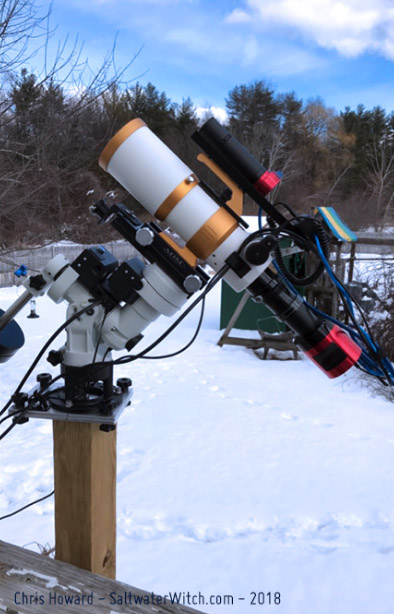 First test shots of M42, the Orion Nebula, M43 De Mairan’s Nebula, Sh2-279 Running Man with the ZWO ASI071MC cooled CMOS camera. No calibration frames, just 17 stacked 300 second light frames, with the sensor cooled to -10C. Last night was not very clear, scattered clouds, fairly poor seeing. I can't wait to test things out with some really clear and dark skies. I definitely need cal frames, because things ended up pretty noisy after processing. I will say, so far, with only a few hours of use, I'm impressed with this ZWO color camera. That doesn't surprise me. ZWO makes a solid camera--I've been using an ASI120MM-S for several years, as my guide camera. It's fast--USB 3, with a small but very sensitive monochrome sensor, and it just always works under any OS on a variety of hardware--Windows, Linux, MacOS. That's what I meant--it shouldn't surprise me that the ASI071MC (quite a bit more expensive and a far more capable camera) just works well. What did surprise me is how much this camera can pick up, bringing out some very faint nebulous areas. I know it has a very wide/high dynamic range. That's one of the things I was looking for in an OSC camera. For this M42 test I used a Gain of 0 and Offset of 8, the minimum recommended by ZWO for long exposure times and HDR (high dynamic range). We'll see how things go on the next clear night. I'd like to test out unity gain settings, and LRN (Lowest read noise) setting, which is high gain, high offset, used for short exposures. (William Optics GT-81 + 0.8x Field Flattener/Reducer f/4.7, ZWO ASI071MC cooled CMOS camera, iOptron CEM25P EQ mount, 30mm mini guide scope with ZWO ASI120MM-S guide cam, INDI/KStars/Ekos observatory control. Location: Stratham, New Hampshire, US. Bortle ~4). Astrobin
First test shots of M42, the Orion Nebula, M43 De Mairan’s Nebula, Sh2-279 Running Man with the ZWO ASI071MC cooled CMOS camera. No calibration frames, just 17 stacked 300 second light frames, with the sensor cooled to -10C. Last night was not very clear, scattered clouds, fairly poor seeing. I can't wait to test things out with some really clear and dark skies. I definitely need cal frames, because things ended up pretty noisy after processing. I will say, so far, with only a few hours of use, I'm impressed with this ZWO color camera. That doesn't surprise me. ZWO makes a solid camera--I've been using an ASI120MM-S for several years, as my guide camera. It's fast--USB 3, with a small but very sensitive monochrome sensor, and it just always works under any OS on a variety of hardware--Windows, Linux, MacOS. That's what I meant--it shouldn't surprise me that the ASI071MC (quite a bit more expensive and a far more capable camera) just works well. What did surprise me is how much this camera can pick up, bringing out some very faint nebulous areas. I know it has a very wide/high dynamic range. That's one of the things I was looking for in an OSC camera. For this M42 test I used a Gain of 0 and Offset of 8, the minimum recommended by ZWO for long exposure times and HDR (high dynamic range). We'll see how things go on the next clear night. I'd like to test out unity gain settings, and LRN (Lowest read noise) setting, which is high gain, high offset, used for short exposures. (William Optics GT-81 + 0.8x Field Flattener/Reducer f/4.7, ZWO ASI071MC cooled CMOS camera, iOptron CEM25P EQ mount, 30mm mini guide scope with ZWO ASI120MM-S guide cam, INDI/KStars/Ekos observatory control. Location: Stratham, New Hampshire, US. Bortle ~4). Astrobin
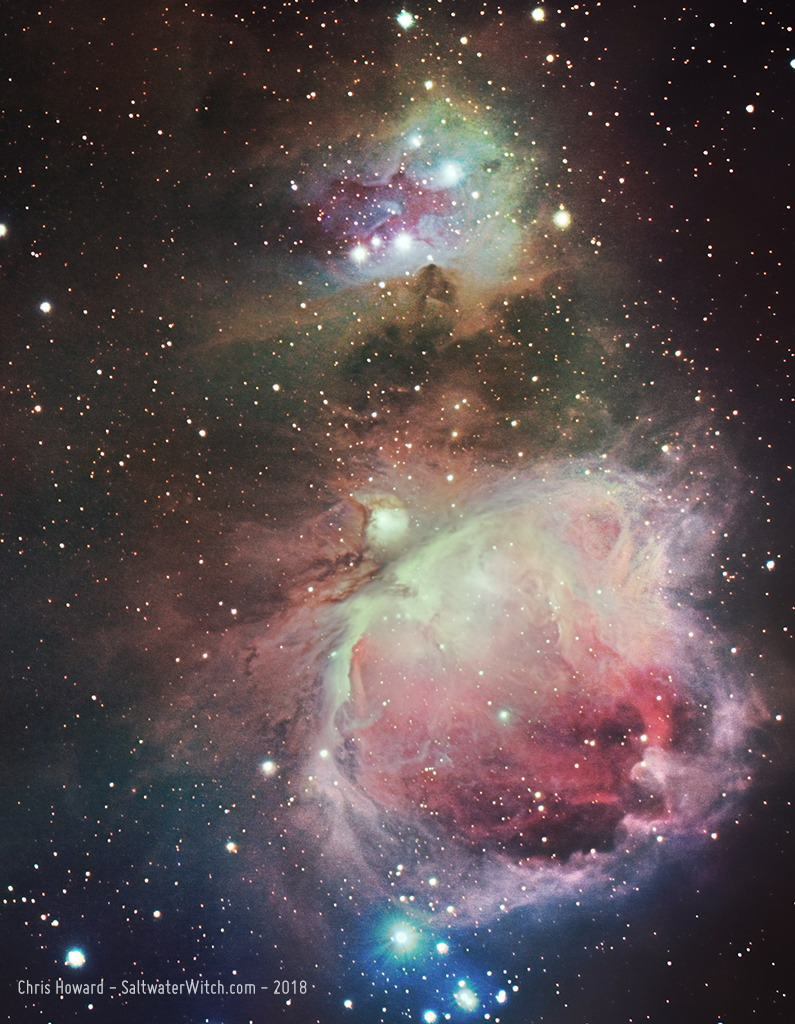
Posted March 11, 2018
Astro Session - February 27, 2018
Our moon is looking especially beautiful tonight, even if it's making it difficult to do some deep space imaging. This is a single frame with the William Optics GT81 refractor and Atik 414EX CCD camera and a Celestron UHC/LPR filter that's been sitting in its box for a couple years--so I thought I'd give it a try. I also added a subtle RGB color layer from a few months back.
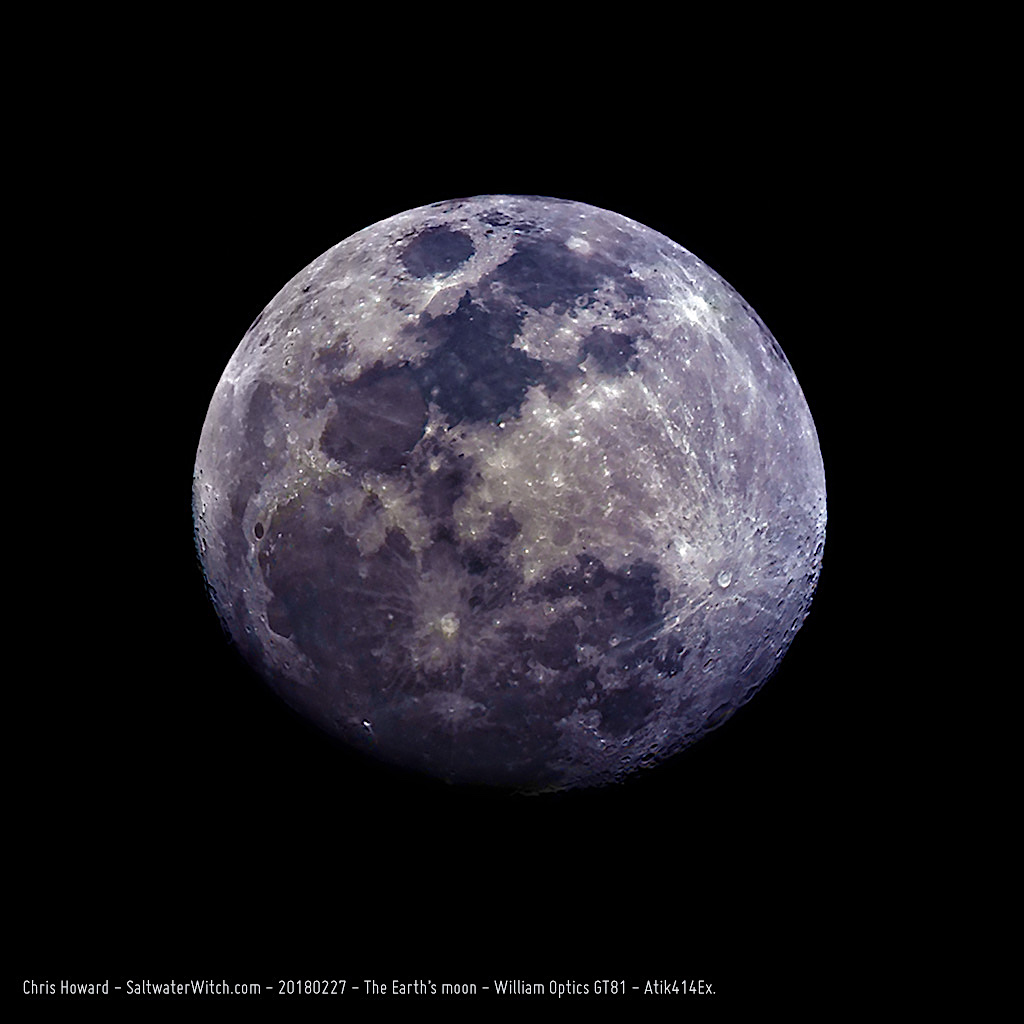
Posted February 27, 2018
Astro Session - February 16, 2018
I took the Nikon D750 out tonight and got a nice 30 second exposure of the constellation Orion (upper right of the first image), with some of the PSNH transmission lines in the foreground. That's Sirius almost center in the shot, with Procyon on the upper left. Centered in the image about a quarter of the way from the top, there's a reddish blur between the star Procyon and the star Betelgeuse in Orion--that's the Rosette Nebula--see my December 26 post. (Nikon D750, 24mm, Hoya LiPo filter, f/4.5, 30 sec. exp. ISO 800). The second shot is M44, the Beehive Cluster in the constellation Cancer--plus a few more stars. (Nikon D750, 24mm, Hoya LiPo filter, f/4.5, 1 x 300 second exposure, ISO 800). These are both single exposures, and I shot both on the iOptron CEM25P mount, and what amazed me was that, with pretty good polar alignment, just using the polar scope (no drift or polemaster), I was able to get 3 and 4 minute exposures unguided. The M44 shot is 300 seconds (5 minutes) with some slight star elongation, but still not a bad shot.
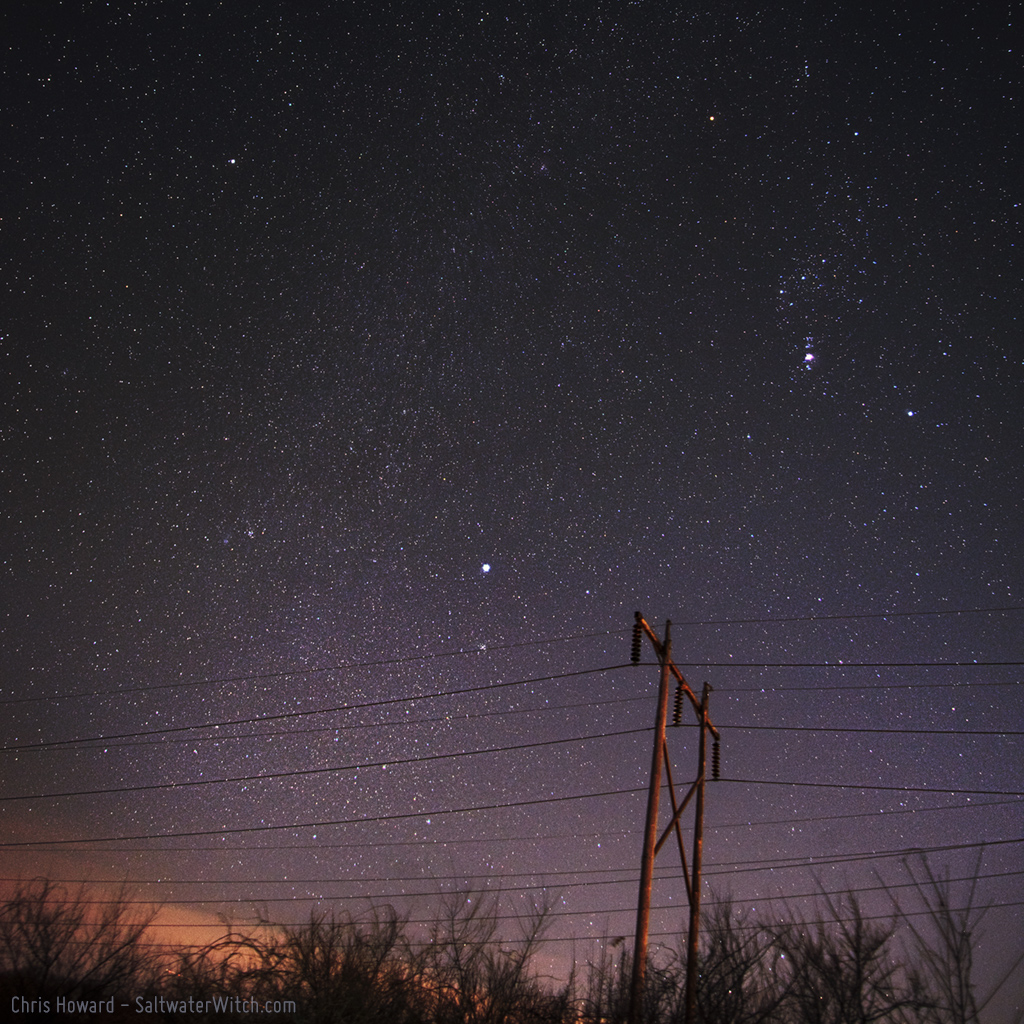
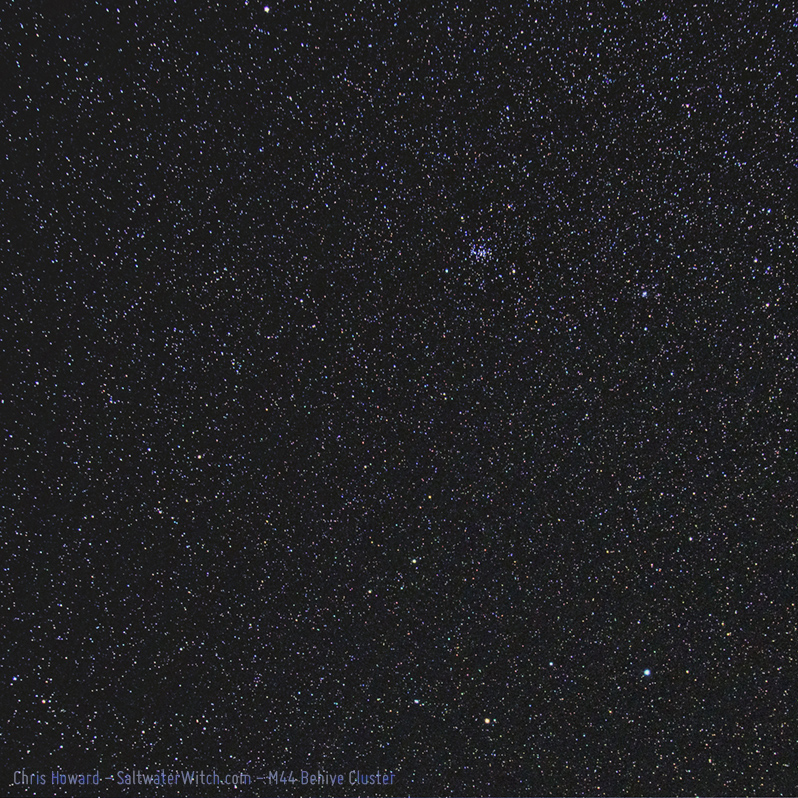
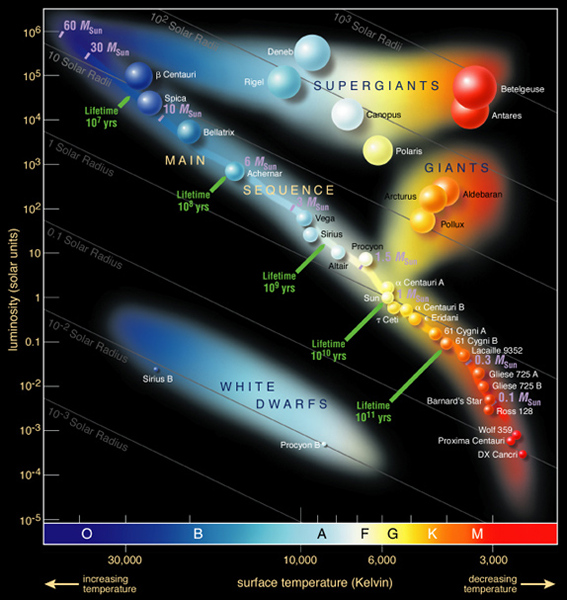 The color of stars is interesting to look for--take a closer look at the Beehive Cluster (M44) image and it's easy to see that the star-field is full of color. I think there's this notion that stars are white pin-points of light in the night sky, but every star has a color, most of them ranging from red to deep blue, depending on many factors including where in its life-cycle it is, the materials it's made from, size, and more. See the Hertzsprung-Russell diagram, listing some of the more familiar stars in our galaxy by surface temperature and luminosity. Our star, the Sun, is pretty close to the middle of the Main Sequence line, between cooler, redder stars and the hotter blue stars. What's interesting is that the shot of the constellation Orion I took the other night--included here--contains several of these stars from the diagram. If you start at the Sun and follow the Main Sequence line up toward the blue end, you will quickly find Procyon, which is the bright star in the top left corner of my image. Sirius--in the diagram--is a couple up from there, but it's almost in the center of my shot. Keep going into the blue, and there's Bellatrix, the blue star which makes up Orion's right shoulder. Now head right from there, out of the Main Sequence line and into the Supergiants, and find the blue supergiant Rigel, which makes up Orion's right foot. And finally, keep going right to the massive red supergiant, Betelgeuse ("Beetle-juice"), which is the left shoulder of Orion. (Hertzsprung-Russell diagram source: ESO - European Southern Observatory, ). How's that for taking one picture of the night sky with some nice examples of stars of varying size, color, and lifespan?
The color of stars is interesting to look for--take a closer look at the Beehive Cluster (M44) image and it's easy to see that the star-field is full of color. I think there's this notion that stars are white pin-points of light in the night sky, but every star has a color, most of them ranging from red to deep blue, depending on many factors including where in its life-cycle it is, the materials it's made from, size, and more. See the Hertzsprung-Russell diagram, listing some of the more familiar stars in our galaxy by surface temperature and luminosity. Our star, the Sun, is pretty close to the middle of the Main Sequence line, between cooler, redder stars and the hotter blue stars. What's interesting is that the shot of the constellation Orion I took the other night--included here--contains several of these stars from the diagram. If you start at the Sun and follow the Main Sequence line up toward the blue end, you will quickly find Procyon, which is the bright star in the top left corner of my image. Sirius--in the diagram--is a couple up from there, but it's almost in the center of my shot. Keep going into the blue, and there's Bellatrix, the blue star which makes up Orion's right shoulder. Now head right from there, out of the Main Sequence line and into the Supergiants, and find the blue supergiant Rigel, which makes up Orion's right foot. And finally, keep going right to the massive red supergiant, Betelgeuse ("Beetle-juice"), which is the left shoulder of Orion. (Hertzsprung-Russell diagram source: ESO - European Southern Observatory, ). How's that for taking one picture of the night sky with some nice examples of stars of varying size, color, and lifespan?
Posted February 16, 2018
Astro Session - February 11, 2018
It's been a cloudy week, and the seven days ahead don't look much better. So I'm digging through some wide-field frames from last summer--to stack and process, and I particularly love this small section of our galaxy, the Milky Way. We are about 26,000 lightyears from the center of our galaxy, all of us on our little blue planet orbiting a G-type main-sequence star. And if you're looking inward, toward the galactic center from our world, you'll see something like the image here (this is a crop of a much wider field of view, so you'll actually see much more, that well-known and aptly-named long pale band across the sky). We are right in the thick of things with our galaxy, which is well over a 100,000 lightyears across and contains as many as 400 billion stars. To put the size of our galaxy in perspective (and keep in mind that 100,000 lightyears is the low side of the approximate diameter, calculated to be between 100,000 and 180,000 lightyears across), we are talking about 587,863,000,000,000,000 miles. So, we'll round up a bit and say our galaxy is at least 588 quadrillion miles across. And to put the size our galaxy in perspective, one of our neighboring galaxies, M31, Andromeda, may be twice the size of the Milky Way, with as many as a trillion stars (It seems like there's always a debate on the size of M31). And if that doesn't make you think about our place in the universe, take a look at this Hubble image and understand that almost everything in the frame, every point and spiral and smear of light is itself an entire galaxy: https://www.nasa.gov/feature/goddard/hubble-spies-big-bang-frontiers. How's that for something to contemplate on a nice Sunday afternoon? You're welcome.
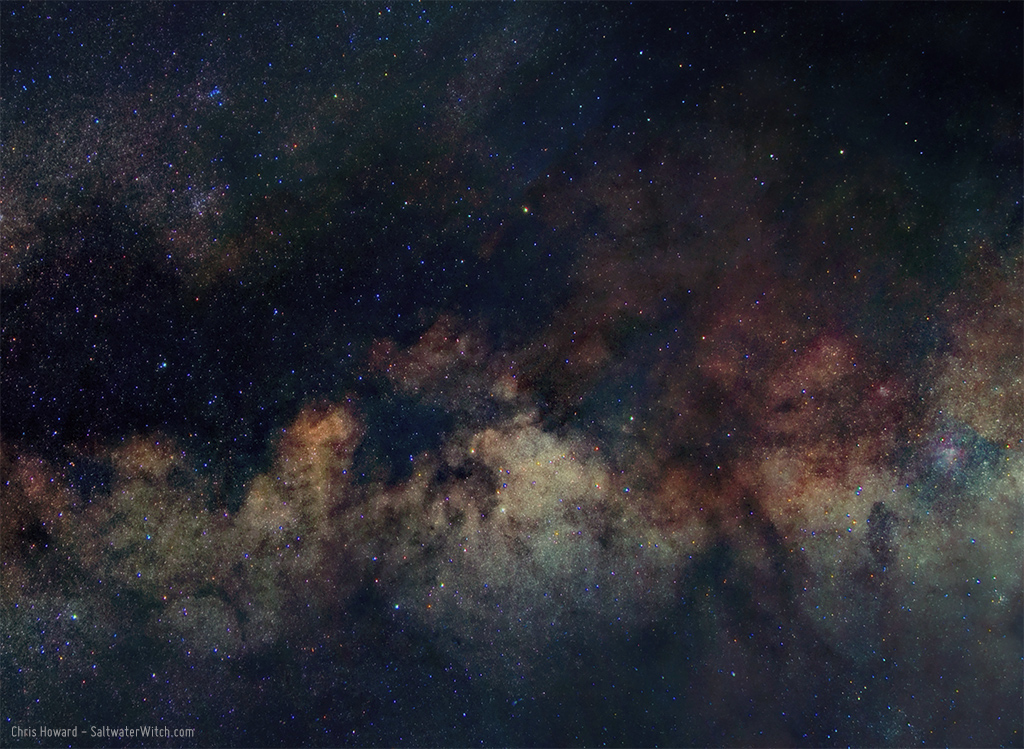
The above shot covers a 30 × 20° FOV of the Milky Way from a little below M17 (Swan Nebula) in the constellation Sagittarius to a little past Delta Aquilae, the bright white star at the bottom left, in the constellation Aquila. Below, is my original shot cropped from M17 on the right to just past Eta Cygni, a variable double star in the constellation Cygnus--about twice the width of the one above. The brightest star in the frame, low center, is Altair.
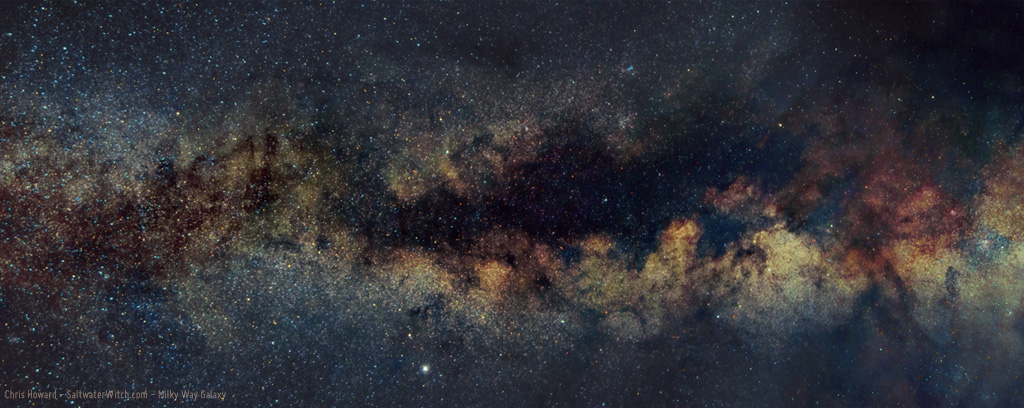
Posted February 11, 2018
Astro Session - January 13, 2018
It's winter and that's when Orion is arguably the main attraction in northern hemisphere skies. HaRGB of the Horsehead Nebula (Barnard 33) along with the reflection nebula NGC 2023 (below and left), part of a whole neighborhood of nebulosity around the leftmost star in Orion's Belt, the blue supergiant Alnitak. (I kept Alnitak out of frame, but it would off to the left with a wider field of view). The Horsehead is an absorption (or dark) nebula about 1500 lightyears from Earth, and shows up so prominently because it's blocking most of the starlight behind it. (10 x 600 second Ha frames, 10 x 240 second RGB frames, 24 dark cal frames taken with an Atik414Ex mono CCD, William Optics GT-81 + 0.8x Field Flattener/Reducer f/4.7, iOptron CEM25P EQ mount, Astronomik 12nm Ha filter, Baader RGB filters, WO 50mm guide scope with ZWO ASI120S-MM guide cam, INDI/KStars/Ekos observatory control. Location: Stratham, New Hampshire, US. ~Bortle 4)
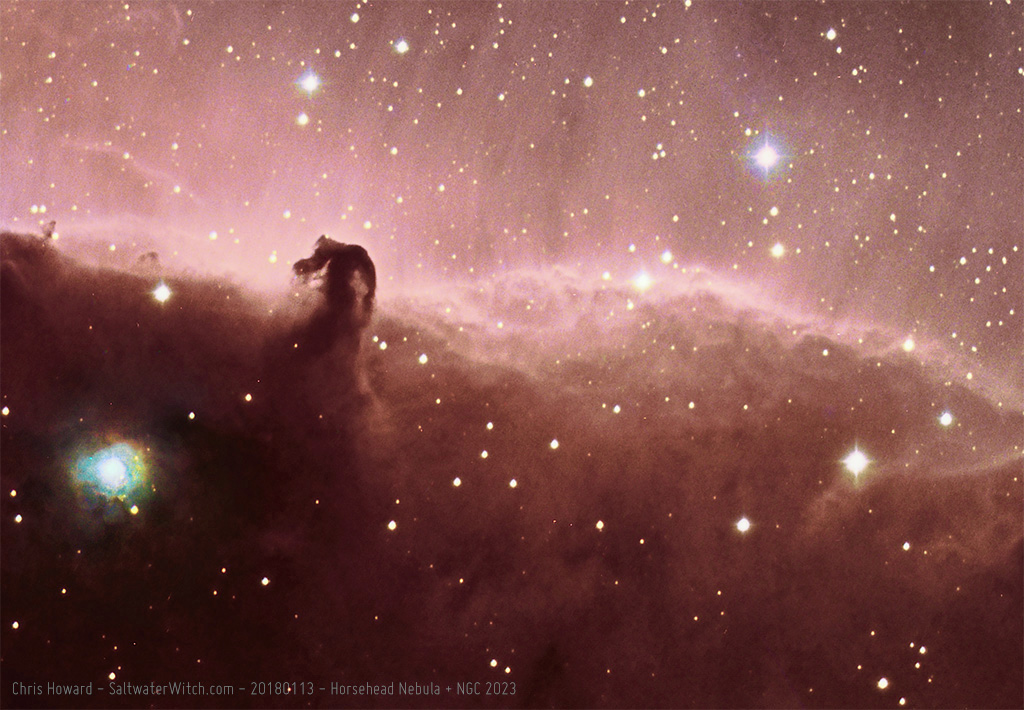
The full FOV for this shot:
